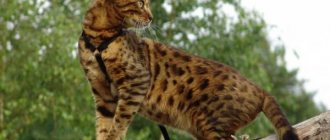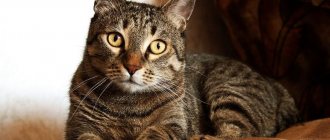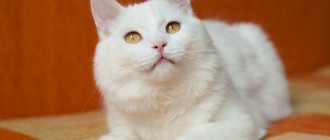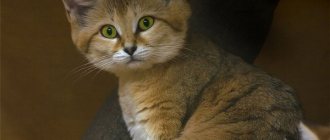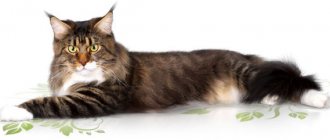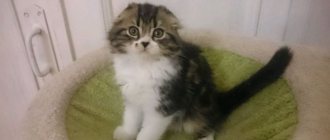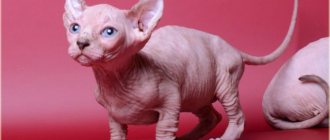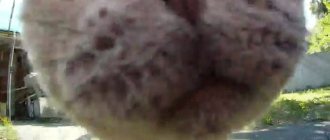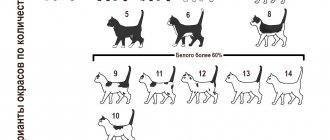11/12/2021 22,518 Cat breeds
Author: Olga
Black cats have long been the heroes of many mystical stories. They have always been companions of everything mysterious and magical, especially with blue eyes. Her symbol is present in Tarot cards. The article is dedicated to these animals, it describes their character and signs associated with them, and also contains photos and video materials.
[Hide]
The character of the "blackies"
Despite prejudices, black cats feel people, their emotions and mood very well. It is not for nothing that they have become an integral attribute of witchcraft. The question arises: why exactly black cats became a magical symbol. It turns out that dark color indeed absorbs negative energy, preventing energy vampires from entering the biofield.
Cats have telepathic abilities, this has been scientifically proven. In relationships with humans, black cats are a kind of barometer. They sense the owner's mood well. Their bioenergy combined with charcoal color gives an amazing result, especially if the pet has an easy-going character.
Black cats not only perfectly relieve nervous stress, but also treat cardiovascular diseases. Doctors recommend getting such a kitten to reduce the risk of a heart attack. If you stroke a pet of a calm nature, tension is relieved and blood pressure normalizes.
By nature, black cats are sociable, playful, and get along well with children. They are physically active with a pronounced hunting instinct. Black kittens love to play with their owner's ball or slipper. Not only a kitten, but also an adult cat with blue eyes can chase a flying fly.
What does a black cat bring into the house?
Cats warn their owners about upcoming troubles. Black cats can often see the future, and many animal owners have noted this more than once.
The black cat that brings into the house:
- There are cases where black cats prevented the onset of misfortune. This happened when a man was in a hurry to go to work, but the black cat hissed and scratched him, so the man did not make it to his bus.
- Later it became known that the transport had an accident and many people were injured. Thus, black cats protect their owners from troubles, protecting them from harm.
- It is believed that animals can help a family have a child. For these purposes, it is usually recommended to have a black cat and a female cat. They attract mutual understanding and love into the family and improve relationships.
Kitty
Breeds
Dark color dominates genetics, so almost every cat breed contains individuals of this color. The classic representative of this species is the Bombay cat, which looks like a panther.
Only black color is recognized in this breed; a kitten of a different color is rejected. The animal's fur is perfectly smooth, charcoal-colored, and does not require constant combing. The shine of a kitten's coat depends on its nutrition. These beautiful cats have a bright temperament.
The Oriental Shorthair is similar to the Bombay breed. Wool also does not require special attention. Beautiful Burmese cats resemble sables in their color. “Blackies” can be such breeds as: American Shorthair, European.
Black cats are common among British people. A plush charcoal-colored kitten with blue eyes does not have a frightening mystical appearance, it can only evoke tenderness and is very attractive in this color.
The dark coat of the Persian breed shimmers beautifully due to the different lengths of the coat and undercoat. A kitten with blue eyes is especially attractive. Other long-haired breeds look no less beautiful: Siberian, Maine Coon and others. In fact, 22 cat breeds are allowed black color according to the standard.
Breed characteristics of black British
The British are rightfully proud of their “signature” British breed of cats - it was bred in Foggy Albion two centuries ago and almost instantly became the most fashionable and popular there. Representatives of the breed received amazing success in 1871 at the famous exhibition in the English Crystal Palace, where British shorthairs of black color were presented - one of the fundamental colors in this breed.
Not every professional nursery can boast of such a chic black Briton
British black cats are second in popularity in the breed, perhaps, only to the famous blue British. They look amazing, and experts at exhibitions often give winning laurels to black Britons - few can compete with them in beauty and showiness. But only specialist felinologists know how much work and experience must go behind the rare success of getting Britons with perfect black fur.
For a long time, English sailors preferred to take black cats with them on voyages - and, as you understand, these were British cats, even if no one knew about this breed yet. Sailors had a superstition that they strictly adhered to: a black cat on a ship is good luck, and good luck certainly doesn’t hurt a sailor. However, the special energy of black cats was appreciated not only by British sailors, but also by the Spaniards - according to some sources, a black cat was also accompanied by a black cat on the famous expedition of Christopher Columbus.
What determines the black color of the British coat?
Color genetics is a very interesting science. And the origin of black color in cats occupies a special place in it. Black is considered one of the most ancient colors in the cat family - it existed long before wild cats became domesticated.
The black Briton looks impressive and mysterious
Monochromatic colors of cats are also called solid - from the English solid (solid, solid). Black solids differ from other solid British ones not only in color, but also in the quality of their wool - it is stiffer and shiny than the matte British “plush” that everyone is familiar with. This happens because microscopic granules of pigment - melanin - are located in the hair “cylinder” more densely than with all other colors. As a result, the hair becomes quite hard and elastic, and not soft and silky, like in the British with a light coat color.
One of two types of melanin is responsible for the black color - eumelanin, the production of which is determined by the presence of the B gene (Black). By being dominant, it gives the coat an anthracite shine and rich blackness - if the dominant gene D (Dilutor - diluent) is also present in the animal's gene set. The recessive form of this gene will result in the coloring of the coat in blurred, as if bleached, and less bright colors: fawn, lilac, all shades of chocolate.
Chocolate color is the same as black, only with the recessive D gene
Thus, the genome of a correct black British must necessarily contain both dominant genes - B and D, otherwise the color will be inexpressive, and the animal, with all its other advantages, will receive the unpleasant status of a breed defect in color.
External features
Black Britons are strong, massive and large cats. The average weight of a mature cat is seven to eight kilograms. Kitties weigh one and a half to two kilograms less than cats.
The black Briton has a powerful physique
The bones of all representatives of the British breed should be wide and powerful, the paws and tail should be short and thick. The muzzle is round, the nose is short, small ears are far apart from each other.
This is what the head of a thoroughbred Briton should (or should not) look like
Experts at exhibitions have high demands on the black color of the British - this is what these beauties should ideally be like:
- shiny, evenly colored from roots to tips, without color gradation or inclusions, with a well-developed undercoat;
- paw pads, whiskers and nose mirror are also painted in rich black;
- eyes - only yellow, preference is given to deep shades (dark yellow and amber, even orange).
A real black Briton is only yellow-eyed
Variations on the Black British Theme
In litters of British cats of various colors, kittens in long-haired fur coats have long been born - this is an echo of the period of the middle of the last century, when Persian blood was actively infused into the breed. Long-haired babies were either discarded or sold much cheaper - as pets, without permission to participate in exhibition and breeding activities. But thanks primarily to the efforts of American felinologists, the British with long thick hair were identified as a separate breed, which in 2009 received authoritative recognition from the international association TICA.
The British Longhair is a young breed, but it has its admirers.
In a young breed, black color is considered one of the most sought after, since long-haired black Britons look especially impressive and are liked by many connoisseurs.
Another attempt to diversify the ancient British breed was, alas, not so successful. Two decades ago, matings between the British and Scots were allowed. In this way, the breeders hoped to improve both breeds: to expand the palette of colors for the British breed, and to improve the quality of the coat and add impressive bulk to the bones of the Scottish breed. Then the so-called British Folds (including black ones) appeared as the fruits of the love of the British with Scottish Folds.
However, the experiment was not successful. There were more disadvantages than advantages - the fold-eared mestizos inherited not the best qualities from the original breeds: for example, diseases of the musculoskeletal system, the basic characteristics of the breed and the quality of the coat also deteriorated; in general, animals began to look less bright and expressive.
British Folds are not recognized as a breed by any felinological organization. Since 2004, the British breed has been considered closed, and mating with Scots is prohibited.
Character and behavior
Black Britons are true gentlemen, aristocrats of their breed. This is manifested not only in appearance, but also in all the habits of this beautiful cat. They are self-sufficient and unobtrusive, have their own opinions on all issues. They are balanced and may seem phlegmatic, but despite their external slowness, they think very quickly and have quick reactions.
They are endowed with a pronounced sense of self-esteem - it’s not for nothing that they are true British. They do not tolerate familiarity, do not seek the owner’s affection, but condescendingly allow themselves to be stroked, and not by everyone, but only by those who deserve such royal favor. Strangers and overly active children are kept at a distance. They never show obvious aggression; they prefer to hide and thereby avoid the conflict.
Black British - comfort and stability in the home
They get along well with other pets as long as they do not try to dominate. They do not feel a constant need for communication and feel great alone.
Everyone who knows black British cats well notes their high intelligence - cats of this color have not only powerful energy, but also an excellent mind
Video: Felix the cat - the perfect black Briton
Breed faults
Black British cats have very few shortcomings, and the happy owners of these cats consider their pets to be ideal. Representatives of this breed are usually long-lived, they rarely get sick and delight their owners with their company for two decades, or even longer. But all this is possible only with proper breeding selection, when responsible breeders thoughtfully form parental pairs, excluding animals with poor heredity from breeding.
The breeder’s task is to get not only beautiful, but also healthy offspring.
What diseases are most common?
British breed cats have a strong immune system, and black British cats, according to breeders, have the best of all. However, all British cats, including black cats, are susceptible to some health problems:
- fungal infections;
- periodontal disease;
- obesity and related problems (heart disease, disorders of the digestive system and musculoskeletal system).
The most serious genetic problem in the UK is the incurable hereditary heart disease - hypertrophic cardiomyopathy. The disease manifests itself in adulthood. A timely identified disease gives the animal a chance to prolong its life - ultrasound diagnostics should be done regularly, starting from the age of one and a half years. All littermates and parents of the affected individual must be removed from breeding programs.
Animals at risk should be examined regularly
Disqualifying faults
The following deviations from the breed standard are considered disqualifying faults for an adult black British dog:
- White spots;
- non-yellow eye color or greenish rim around the iris;
- non-black color of paw pads or nose;
- non-standard number of fingers;
- defects and pathologies of the tail, including kinks and kinks;
- significant violations of the dental system.
A purebred black Briton is the star of any show.
The expert's assessment can be significantly affected by any deviations from the correct black color: its unevenness or insufficient color saturation, elements of the pattern on the coat.
Signs about black cats
There are many signs associated with these creatures; they are the most controversial all over the world. In many European countries, as well as in the USA and our country, it is believed that a black beast crossing the road is bad luck. To get rid of an unpleasant forecast, you had to do the following:
- spit over your left shoulder;
- cross the cat's path by putting a fig in your pocket or holding a button;
- wait for someone else to cross the road.
In England and Japan, a “blackie” who runs across brings good luck. The British are very kind to black cats. British sailors specially take these animals on their ships to ensure a successful voyage. If a black kitten with blue eyes appears on the doorstep, it should be sheltered, then it will bring prosperity to the house. If you drive away this blue-eyed animal, it can bring misfortune. For the Scots, a black fluffy cat sitting on the porch was a sign of wealth in the house.
In ancient Egypt, black cats were considered divine beings and were kept as temple animals due to their calm nature. In the Middle Ages, they were considered servants of Satan and an integral attribute when performing witch rituals. There were even public burnings of animals. It was a salvation if there was at least one white spot on the body.
But black cats living in the house are already considered a good sign. In this case, they are credited with driving away evil spirits and protecting homes from thieves. Thanks to their calm nature, they create a cozy atmosphere in the home. If a coal-colored cat sneezes not far from the bride, it means the marriage will be successful.
Sorry, there are no surveys available at this time.
Thus, there are many positive and negative signs with the “darlings”. Everyone has the right to believe in them or not, but animals should not suffer from it.
Black cat: can I keep it at home?
If you want to improve your financial situation, be sure to get a black cat. It is believed that due to the accumulation of energy, the animal can attract money and help preserve it.
Black cat, can be kept at home:
- Even if you don’t change your job, your work activity will remain the same, you will notice that you have a different attitude towards money. Instead of buying yourself the tenth cup of coffee a day and useless nail polish, you will be able to save money that will significantly help you out in the future, or allow you to go on vacation to exotic countries.
- Black cats very often warn their owners of approaching danger. They usually sense otherworldly forces that are not very well disposed towards you. Cats can react very ambiguously to strangers and neighbors.
- In relation to some friends who come to your home, cats can show open aggression, bite, growl and hiss. Most likely, the person is not honest towards you, wants to carry out some kind of meanness, or has a bad attitude. You should stay away from such people.
Black cat
Video “Mystical stories about a black cat”
This video talks about the Bombay "blackies" and their mystical abilities.
Was this article helpful?
Thank you for your opinion!
The article was useful. Please share the information with your friends.
Yes
No (100.00%)
X
Please write what is wrong and leave recommendations on the article
Cancel reply
Rate the benefit of the article: Rate the author ( 5 votes, average: 4.80 out of 5)
Discuss the article:
How to choose a Black British kitten
Surprisingly, it's true: many gorgeous black Britons grew up as homely, bad boys. And an absolutely charming black kitten can grow into a mediocre, not at all show-worthy representative of the breed. How not to make a mistake when choosing a kitten?
This is not an “ugly duckling”, but a very purebred British kitten
Don't go for cheap
The British breed is quite popular and numerous; Both on the Internet and at bird markets you will find many offers for the sale of small British birds, including black ones. Often, the kitten comes with documents - nowadays it’s not a problem to “draw” any piece of paper, the authenticity of which most buyers will not delve into.
And everyone seems to be happy: the seller received the money, the kitten received its owners, and the buyers received the desired pet. Well, what will grow out of it will grow... If the deceived owners do not have exhibition ambitions, then the dubious breed of such an acquisition is not the biggest evil. What is much worse is that scammers and breeders are least concerned about the health and proper raising of babies, but here very unpleasant problems can arise.
But this little charm, alas, has nothing to do with the British breed
Don't want to become a victim of scammers? Then don’t give them a chance - listen to these simple recommendations:
- A purebred animal is not bought “cheaply” from random people - competent breeding work is always very expensive, and its results cost a lot of money.
- Contact reputable breed nurseries - professional breeders are responsible for breeding and protect their reputation.
- Buy a kitten under an agreement with the breeder - this is an elementary culture of modern breeding and a guarantee that you will not be deceived.
- Study the breed standard and involve specialists in your selection - if you have basic knowledge about the breed, you will make a conscious, not an emotional purchase.
Read the breed standard
You are ready to buy a black British man - a wonderful choice. What kind of British kitten do you want to buy - short-haired or long-haired? As we have already said above, recently these are different breeds, although they differ only in the length of the fur, and in the main aspects the breed standards are completely the same.
What should you first of all pay attention to in order to purchase a truly purebred animal, and not at least a mestizo or a completely outbred black charmer? It is no coincidence that the British love the saying: “It all starts with the head” - and in our case this is a very accurate definition. The head of a little Briton can “tell” a lot to a breed connoisseur, which will help him make the right choice.
When choosing a kitten, pay attention to the structure of its head.
From the front, the kitten's muzzle resembles an almost perfect circle with small, widely spaced ears and expressive “button” eyes. In childhood, the Briton's head is larger than that of kittens of other breeds, and the ears are smaller. The breed and constitution “give it away” - the body of a British kitten is tightly built, the tail is relatively short, and the legs are short and plump.
Look to the root
Even if all the previous rules were followed and you did get a kitten from a good British family, it is too early to calm down. A decent pedigree, alas, does not guarantee that a cute baby will grow into a cat with the “correct” black color. The fact is that black Britons have an interesting property of dramatically changing colors after a complete change of teeth and the onset of puberty.
Only by seven to eight months of age will it be possible to say with a high degree of confidence what the fur of this teenage kitten will be like. Therefore, if you plan to get a show animal, buy a grown animal whose adult coat is already sufficiently formed.
The grayish childish color of the Briton may soon turn black and sparkling
Experienced breeders have a sign that will almost accurately predict which of the black kittens in the litter will receive the correct and high-quality color when they grow up. If a baby develops the rare “black smoke” color by about two months, then with the final color change, this particular kitten will most likely receive a luxurious fur coat, bright black and sparkling. Look at the very roots of the hairs - if they are lighter there than at the tips, then take a closer look at this baby.
There is hardly any need to worry if single white hairs are found on the coat of a little Briton - they will not remain on the adult coat. Small white pinches or rips will also disappear if the skin underneath is grayish and not pink. But whether the white “medallions”, brownness and unevenness of color will go away - no one can guarantee you this.
Such eyes will definitely acquire an amber color.
From my own experience: I can reveal one more secret that will help you understand at a very tender age whether the baby’s eyes will be a rich, deep yellow color, which is so highly valued among the British, or completely light. It's simple. If a kitten’s eyes are bright blue, a wonderful heavenly shade, as they grow older, alas, they will become faded and dull - a big minus at the exhibition. The closer the color of a child’s iris is to gray, the better colored this Briton’s eyes will be.
How to care for a black British man
The popularity of Black British dogs is explained not only by their spectacular appearance and positive character, but also by the ease of keeping this breed at home.
Hygiene
The coat of Black British cats is easier to care for than that of other representatives of the breed, since it is stiff and elastic, gets dirty less and is easier to clean itself. Some owners argue that these cats don’t need to be bathed at all - they themselves perfectly resolve all issues of their own hygiene. But it is not so.
Yes, the British constantly monitor the cleanliness of their fur coat, but sometimes it still needs to be washed using special cat shampoos. They are bathed infrequently - once every six months. An exception to this rule is when preparing for a show or when your pet's fur is very dirty.
Black British cats love to wash themselves
Human shampoos cannot be used on cats - dandruff or allergic reactions and dermatoses may occur. Black British cats do well with cat shampoos for dark coats. Various manufacturers have such cosmetics, but it is better to give preference to expensive brands - cheaper options can deprive the British fur of its wonderful shine.
Advice from my own experience: a brownish tint on black wool can be eliminated by using shampoos... for white wool. These products usually do not have a banal lightening effect - but they effectively remove all elements of yellowness and brownness from the fur, making the natural color brighter. When choosing such a shampoo, pay attention to its composition - the more natural it is, the better.
Don't bathe your pet too often - it won't benefit his coat.
For British Shorthairs, one brushing per week is enough; shedding hair needs to be brushed more often. During periods of seasonal molting, the fur coat should be combed three times a week using a furminator. At this time, it is recommended to introduce vitamin supplements into the diet that are produced specifically for this breed.
Ears, eyes, teeth and claws require special attention - everything that the animal cannot care for on its own. Ordinary hygiene involves wiping the inner surface of the ears and the perimeter around the eyes with cotton pads lightly dipped in cool boiled water or a special lotion.
Eyes need to be cleaned daily, ears weekly, without going deep into the ear canal. To clean teeth, use special pastes and brushes that are sold in pet stores. Claws, if they do not grind down on their own, are trimmed as they grow. It is advisable to lubricate the claw sections with antifungal drugs.
Feeding
The British can boast of an excellent appetite and pickiness in food. The black Briton is by no means an exception in this sense. Both high-quality dry food and natural nutrition are suitable for him. The pet industry offers a large selection of ready-made foods designed specifically for British cats - they are available in the lines of many well-known brands.
If your pets are sterilized or lead a sedentary lifestyle, you will need to pay special attention to the selection of food - it should be of high quality, but low in calories. It is impossible to overfeed the British, representatives of this breed are prone to obesity. But water, fresh and clean, should always be in sufficient quantities.
It is more difficult to choose a natural diet for a black Briton - so that it is healthy, varied and balanced. It is recommended to include the following products in the cat's menu:
- boneless veal or poultry;
- boiled sea fish;
- low-fat fermented milk products;
- quail eggs;
- boiled or fresh vegetables.
Fresh meat should make up at least half of a black Briton's diet
It is very useful to give your pet seaweed - kelp - once a week, which helps improve the quality of the coat and saturate the black color. Important: kelp must be fresh or dried - pickled seaweed should not be given. Pickled, spicy, smoked, fatty and fried foods are harmful to cat digestion. You also can’t “pamper” the British with sweets and fresh baked goods.
Toilet
Smart British kittens start using the litter box early. They are very clean and easy to train, so in their new place of residence there are usually no problems in this regard. The only thing worth paying attention to is that the tray should be quite spacious and comfortable, since British cats have impressive dimensions. Usually, closed toilets are purchased for this breed.
Trust the choice of litter for the tray to the preferences of your pet. Find out in a timely manner from the breeder what type of litter the kitten has gotten used to, and buy the same one for him.
For long-haired British cats, wood and low-quality mineral fillers are not recommended - when wet, they turn into a sticky substance that stains the elongated fur on the paws and then spreads throughout the house.
